Music
"Ah, that shows you the power of music, that magician of magicians,
who lifts his wand and says his mysterious word and all things real
pass away and the phantoms of your mind walk before you clothed in
flesh."
Mark Twain - Personal Recollections of Joan of Arc
|
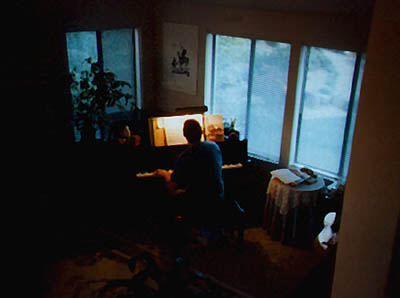
|
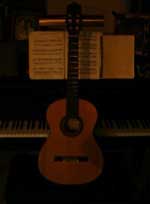 The original "Songbird" was "Songbird Software", a company I started
more than 25 years ago, when the MIDI standard was first implemented.
Prior to that I had implemented programs to generate music on early
home computers, the best of which was a program on a Commodore-64 that
improvised the blues. I felt that the widespread adoption of the MIDI
standard would create a huge demand for music software.
The original "Songbird" was "Songbird Software", a company I started
more than 25 years ago, when the MIDI standard was first implemented.
Prior to that I had implemented programs to generate music on early
home computers, the best of which was a program on a Commodore-64 that
improvised the blues. I felt that the widespread adoption of the MIDI
standard would create a huge demand for music software.
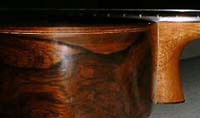
I was right. However, at least 40,000 other people had the same idea,
and many of them had a lot more time, money, and marketing skill
than I did.
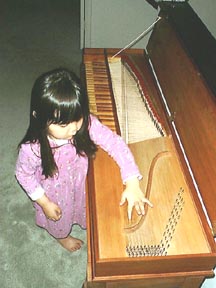 I noodle around on keyboard and guitar. A few years back I built a clavichord from a kit, and I
have been slowly working on a couple other instruments in my spare
time -- You can see a picture of the painted soundboard of a harpsichord
on this page.
I noodle around on keyboard and guitar. A few years back I built a clavichord from a kit, and I
have been slowly working on a couple other instruments in my spare
time -- You can see a picture of the painted soundboard of a harpsichord
on this page.
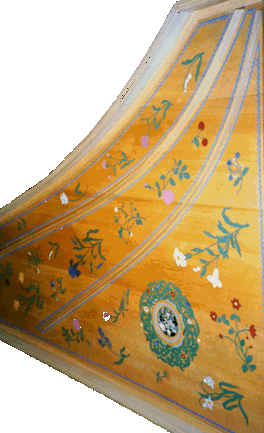 .
But progress is slow, and instrument making isn't my forte; a
few years ago I bought a clavichord made by Gary Blaise, and I'm slowly
learning to play it.
.
But progress is slow, and instrument making isn't my forte; a
few years ago I bought a clavichord made by Gary Blaise, and I'm slowly
learning to play it.
We have a Yamaha baby grand, a couple of clavichords, and an old DX-7
synthesizer. I have several guitars, including a wonderful old
classical guitar made by Antonio Marin Montero, his 255th guitar, made
in 1980.
Here's that guitar in a very lo-fi .wav file, of a Courant, by J S Bach (1.6MB).
And here's another file, an improvisation called, with sincere humbleness,
"Kent's blues" (1.3MB)
One thing that MIDI allows you to do is to play weird things
perfectly. I have created quite a few of these weird things -- I say
"things", because they are not really music -- I think of them more
as "sculptures in sound". Frequently they are generated by some
mechanical algorithm -- for example, here's a piece that is generated
from the source code to an encryption algorithm. It's called "rsa". [Actually, I wrote a program that
will convert any text file to sound. This particular text has an
aesthetic appropriateness I won't try to explain at this point.
Anyone interested in the algorithm can view the source here.]

Sound sculptures can be based on music, but there is a subtle static
quality about them that is hard to describe. Here, for example, is a
partially complete version of an old Cole Porter Tune, "Love for Sale" (This was an exercise in a music
generation language I called "aml", a pure text representation of music. The
"source code" for the song is here. The aml
compiler converts the text to a midi file, which I then converted to an ogg.
Unfortunately, this was all done so long ago that I am no longer sure I
could reconstruct what I did :-( .)
Here's a bit of algorithmically generated "music", called "y". You will need a bit of patience to listen to it.
I took piano lessons for a number of years, then decided to focus on the
clavichord. I haven't had a teacher -- my pedagogical plan is to learn every
keyboard piece by JS Bach, in approximate order of difficulty. I figure that
all his children must have learned clavier technique on a clavichord, so the
simple pieces he wrote must have worked on the clavichord. Common sense
tells us, therefore, that as teaching pieces they would have had to be
written with the characteristics of the clavichord in mind. Here's a couple
of terrible recordings: bach 1 and bach 2. I think it's the Gary Blaise clavichord,
because the tone is pretty clear, but I can't remember for sure. (These
recordings were made several years ago). Clearly, I still have a very long
way to go...

 The original "Songbird" was "Songbird Software", a company I started
more than 25 years ago, when the MIDI standard was first implemented.
Prior to that I had implemented programs to generate music on early
home computers, the best of which was a program on a Commodore-64 that
improvised the blues. I felt that the widespread adoption of the MIDI
standard would create a huge demand for music software.
The original "Songbird" was "Songbird Software", a company I started
more than 25 years ago, when the MIDI standard was first implemented.
Prior to that I had implemented programs to generate music on early
home computers, the best of which was a program on a Commodore-64 that
improvised the blues. I felt that the widespread adoption of the MIDI
standard would create a huge demand for music software.

 I noodle around on keyboard and guitar. A few years back I built a clavichord from a kit, and I
have been slowly working on a couple other instruments in my spare
time -- You can see a picture of the painted soundboard of a harpsichord
on this page.
I noodle around on keyboard and guitar. A few years back I built a clavichord from a kit, and I
have been slowly working on a couple other instruments in my spare
time -- You can see a picture of the painted soundboard of a harpsichord
on this page.
 .
But progress is slow, and instrument making isn't my forte; a
few years ago I bought a clavichord made by Gary Blaise, and I'm slowly
learning to play it.
.
But progress is slow, and instrument making isn't my forte; a
few years ago I bought a clavichord made by Gary Blaise, and I'm slowly
learning to play it.